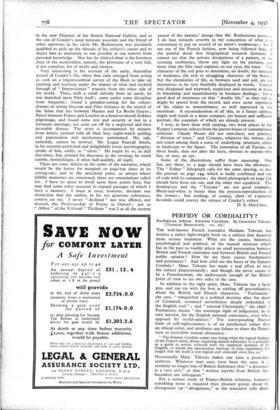CHARLES CONDER
MR. ROTHENSTEIN continues happily his double work of Gallery Director and writer, now he is installed at Millbank, by services to the memory of a painter who has fallen too much out of favour in these strident times. He has disposed Condor's reveries in appropriate contiguity to Whistler, whose master-works now obtain a better place in the re-hung rooms, and he has replaced Frank Gibson's well-meant but ineffective volume by a substantial tribute. This book makes a notable advance upon the author's previous publications both by quitting well-trodden tracks for more original matter, and in the manner of its writing. The introductory chapter and critical parts generally show a balance of judgement welcome
in the new Director of the British National Gallery, and as the son of Conder's most intimate associate and the friend of other survivors in his circle Mr. Rothenstein was peculiarly qualified to pick up the threads of his subject's career and to depict him as intimately as was possible at one remove from . personal knowledge. Nor has he shirked what is the foremost duty of the memorialist, namely, the provision of a very full, if not complete, list of works and owners.
Very interesting is his account of the early, Australian period of Conder's life, when that exile emerged from acting as cook on a trigonometrical survey of the Bush to take up painting and teaching under the impact of what had trickled through of ` Impressionist " practice from the other side of the world. Then, with a small subsidy from an uncle, he was launched upon Paris itself ; came under some discipline from Anquetin ; found a paradise-setting for his colour- dreams of spring blossom and Fetes Galantes in the stretch of
• the Seine that lies between Mantes and La Roche Guyon ; flitted between France and London in a hand-to-mouth feckless pilgrimage, and found some rest and security at last in a fortunate marriage, too soon cut off by a neglected and then incurable disease. The story is accompanied by extracts from letters, printed with all their lazy, night-watch spelling and punctuation and incoherence untrimmed. His talk, unluckily, cannot be revived. Mr. Logan Pearsall Smith, in his recently-published and delightfully ironic autobiography, speaks of him, oddly, as " silent." He might be so, in dull day-times, but, primed for discourse in the evening, he could ramble, bewitchingly, if often half-audibly, all night.
There are some defects in the order of the narrative, which
• would be the better for marginal or page-top dates in its setting-out; and in the anecdotal parts, as always where fallible memories are concerned, there are emendations called for. I have no space to dwell upon these points here, but may find some other occasion to expand passages of which I have a memory. I must at once, however, disclaim one distinction that the author, in his too generous references, confers on me. I never " declined " nor was offered, nor desired, the Professorship of Poetry at Oxford ; nor as " Abbot " of the Vetheuil " Theleme " was I at all the austere censor of the inmates' doings that Mr. Rothenstein portrays. I do lean towards severity in my conception of what it is convenient to put on record of an artist's weaknesses ; but I am out of the French fashion, now being followed here, of the painful detail that biographical research demands. I cannot see that the private dissipations of a painter, or his seeming snobberies, throw any light on his pictures, any more than the Nile mud explains, to our eyes, the lotus. The character of the soil goes to determine, no doubt, the strength or weakness, the rich or struggling character of the flower ; but the chemistries of life, as between seed and soil, are too mysterious to be very fruitfully displayed in words. Conder was dissipated and wayward, suspicious and tiresome at times in friendship and unsatisfactory in business dealings ; but a good deal of insistence on that " double life," as they call it, might be spared from the record, and even some repetition of his claims to remembrance, so well expressed in the exordium. A reconsideration of all this, in a future edition, might well result in a more compact, yet honest and sufficient portrait, the essentials of which are already present.
I note, to have done with carping, two weak places in the Keeper's armour, echoes from the parrot-house of contemporary criticism. Claude Monet did not introduce, nor practice, " division of tones," and Cezanne, whatever his virtues, did not count among them a sense of underlying structure, either in landscape or the figure. The reiteration of all Europe, on those heads, does not alter the facts, obvious to anyone who has, or uses, an eye.
Some of the illustrations suffer from squeezing. One fan, not three, to a page should have been the allowance. The " Esther " lithograph calls for the same spacing, as also the portrait on page 144, which is badly combined and out of scale with its companion ; the third photograph on page 193 should have been cut out, and the other two equalised. The frontispiece and the " Toccata " are not good examples. Black-and-white is better than the process-reproduction of the former ; but nothing, of course, short of expensive facsimile could convey the virtues of Conder's colour.
D. S. MACCOLL.











































 Previous page
Previous page